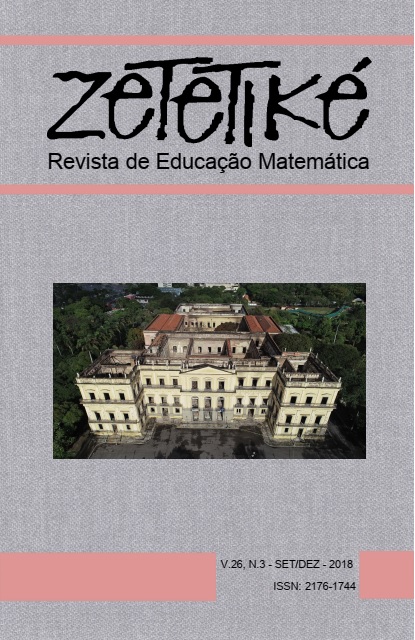Resumo
Este artigo enquadra-se numa experiência de formação inicial com futuros professores e educadores. O objetivo é compreender de que forma as tarefas exploratórias podem contribuir para o desenvolvimento do raciocínio espacial e quais os processos de raciocínio que promovem. Os dados foram recolhidos por registos áudio e vídeo e a sua análise incidiu nos processos de construção, análise e transformação de modelos mentais e operações com modelos mentais. O estudo sugere que o tipo de tarefas propostas, os recursos e as interações na sala de aula são condições relevantes para a ativação destes processos. No que respeita às tarefas, a realização de contagens de elementos dos poliedros e o estabelecimento de relações e justificações revelam-se promotores dos processos de raciocínio espacial; o material manipulável é importante como suporte, mas a sua utilização deve ser limitada; e o contexto de trabalho colaborativo favorece a comunicação do raciocínio e a estruturação espacial.
Referências
Atiyah, M. (1982). What is geometry? The 1982 Presidential Address. The Mathematical Gazette, 66(437), 179-184.
Battista, M. T. (2007). The development of geometric and spatial thinking. In F. K. Lester (Ed.), Second handbook of research on mathematics teaching and learning (pp. 843-908). Greenwich, CN: Information Age.
Battista, M. T. (2009). Highlights of research on learning school geometry. In T. V. Craine & R. Rubenstein (Eds.), Understanding geometry for a changing world (pp. 91-108). Reston, VA: NCTM.
Battista, M. T., & Clements, D. H. (1996). Students' understanding of three-dimensional rectangular arrays of cubes. Journal for Research in Mathematics Education, 27(3), 258-292.
Chapman, O. (2013). Investigating teachers’ knowledge for teaching mathematics. Journal of Mathematics Teacher Education, 16(4), 237-243.
Cobb, P., Confrey, J., diSessa, A., Lehrer, R., & Schauble, L. (2003). Design experiments in educational research. Educational Researcher, 32(1), 9–13.
CBMS (2000). Mathematical Education of Teachers Project. Washington, DC: American Mathematical Society.
CBMS (2012). Mathematical Education of Teachers II. Washington, DC: American Mathematical Society.
Clements, D. H., & Sarama, J. (2011). Early childhood teacher education: the case of geometry. Journal of mathematics teacher education, 14(2), 133-148.
Duval, R. (1999). Representation, vision and visualization: Cognitive functions in mathematical thinking. Basic issues for learning. In F. Hitt & M. Santos (Eds.), Proceedings of the 21st North American PME Conference, 1, 3-26.
Gutiérrez, A. (1996). Visualization in 3-dimensional geometry: In search of a framework. In L. Puig & A. Gutierrez (Eds.), Proceedings of the 20th PME International Conference, 1, 3-19.
Johnston-Wilder, S., & Mason, J. (Eds.). (2005). Developing thinking in geometry. London: Sage.
Jones, K., Mooney, C., & Harries, T. (2002). Trainee primary teachers’ knowledge of geometry for teaching. Proceedings of the British Society for Research into Learning Mathematics, 22(2), 95–100.
Jones, K., & Tzekaki, M. (2016). Research on the teaching and learning of geometry. In A. Gutiérrez, G. C. Leder & P. Boero (Eds.), The second handbook of research on the psychology of mathematics education (pp. 109-149). Rotterdam: Sense.
Kuzniak, A. (2013). Teaching and learning geometry and beyond… In B. Ubuz, Ç. Haser & M. A. Mariotti (Eds.), Proceedings of the eighth congress of the European Society for Research in Mathematics Education (pp. 33-49). Turkey: Ankara.
Malkevich, J. (2009). What is geometry? In T. V. Craine & R. Rubenstein (Eds.), Understanding geometry for a changing world (pp. 3-16). Reston, VA: NCTM.
Menezes, L., Serrazina, L., Fonseca, L., Ribeiro, A., Rodrigues, M. Vale, I., … Tempera, T. (2014). Conhecimento de geometria de alunos da licenciatura em Educação Básica. Atas do XXV Seminário de Investigação em Educação Matemática. Braga.
National Council of Teachers of Mathematics (NCTM) (1994). Normas profissionais para o ensino da Matemática. Lisboa: APM e IIE.
Ponte, J. P. (2005). Gestão curricular em Matemática. In GTI (Ed.), O professor e o desenvolvimento curricular (pp. 11-34). Lisboa: APM.
Ponte, J. P. & Chapman, O. (2008). Preservice mathematics teachers’ knowledge and development. In L. English (Ed.), Handbook of international research in mathematics education (2nd ed., pp. 225-263). New York, NY: Routledge.
Presmeg, N. C. (2006). Research on visualization in learning and teaching mathematics. In A. Gutiérrez, P. Boero (Eds.), Handbook of Research on the Psychology of Mathematics Education: Past, Present and Future (pp. 205-235). Rotterdam: Sense.
Projecto Matemática para Todos (s.d.). Investigações na sala de aula—propostas de trabalho. Lisboa: APM
Sinclair, N., Bussi, M. G. B., De Villiers, M., Jones, K., Kortenkamp, U., Leung, A., & Owens, K. (2016). Recent research on geometry education: An ICME-13 survey team report. ZDM Mathematics education, 48(5), 691-719.
Steele, M. D. (2013). Exploring the mathematical knowledge for teaching geometry and measurement through the design and use of rich assessment tasks. Journal of Mathematics Teacher Education, 16(4), 245-268.
Veloso, E. (1998). Geometria: Temas actuais. Lisboa: IIE.
Watson, A., & Mason, J. (2007). Taken-as-shared: A review of common assumptions about mathematical tasks in teacher education. Journal of Mathematics Teacher Education, 10(4), 205-215.
Whiteley, W., Sinclair, N. & Davis, B. (2015). What is spatial reasoning? In B. Davis & Spatial Reasoning Study Group. Spatial reasoning in the early years: Principles, assertions, and speculations (pp. 3-14). New York, NY: Routledge.

Este trabalho está licenciado sob uma licença Creative Commons Attribution-NonCommercial-NoDerivatives 4.0 International License.
Copyright (c) 2018 Zetetike


